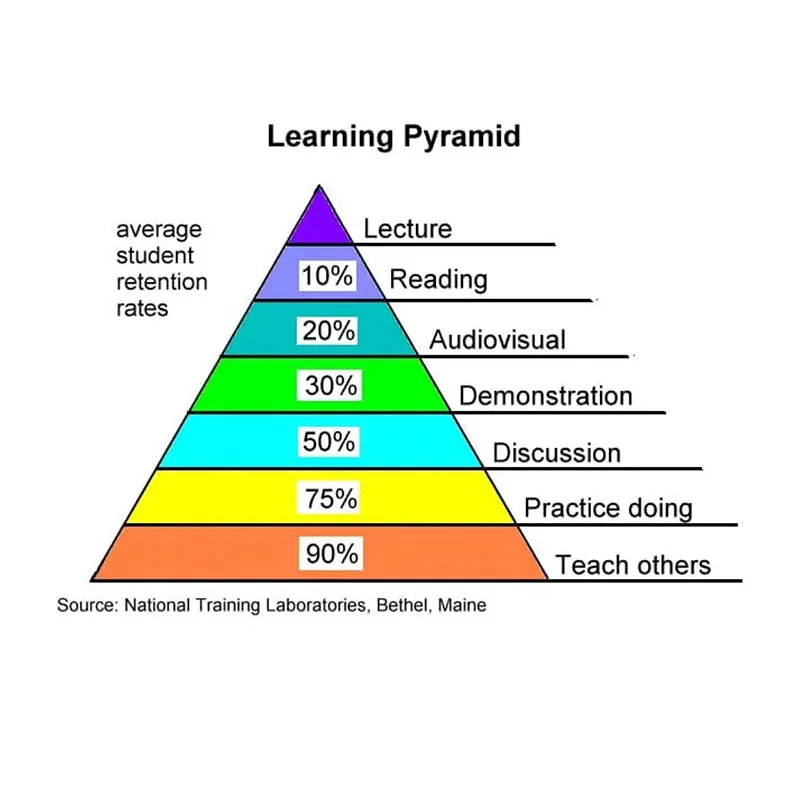How to Select the Right Training Courses

“You are creating through your choices, even now. Choose wisely.”
― Bryant McGill, Voice of Reason
As an L&D professional, you know all too well that just as you have your own preferred teaching method(s), learners also have their own preferred way or style of learning. And just as it can be tricky for you as a trainer, educator, or facilitator to choose the best training method that will have the greatest impact on employees, employees, in the age of fast-paced technological change, are now also faced with the tricky task of choosing courses and training programs that best align with their needs, goals, and desires.

Table of Contents
Let’s Reverse the Roles: From Trainer to Employee
Thanks to the evolution of tech and the internet, employees have more and more power to take their professional learning and development into their own hands. Online (or rather elearning) courses are literally just a mouse click away, and many of these courses are either free or super affordable.
But here’s the thing: There are just TOO many courses to choose from, and when employees seek out a course for themselves without professional guidance and input, they could be choosing, or even paying for, courses that are, to put it bluntly, a waste of time or offer no real lasting benefit.
And that’s why we’ve decided to write this article on how you, as an L&D professional, can help employees cope with the abundance of choice when it comes to choosing a course that incorporates their preferred learning styles and one that will motivate them to learn and help them with knowledge transfer and retention and skill acquisition.
From here on out, this article will become a guide – that you as the professional can use – for employees to help them make valuable choices and more informed decisions when it comes to their learning and development. So let’s switch it up a little, shall we? How about you, even though you are the L&D professional here, pretend you are an employee who is overwhelmed with the abundance of available online learning and development courses? What advice and guidance would you like to be given?
So, switch up the roles and pretend you’re the employee – just for this five-minute read. A little shift in perspective always helps, right?! Now this is a game, because who doesn’t appreciate the value of gamification when it comes to learning?! So, do your best and pretend you’re an employee who doesn’t have the wealth of knowledge you do regarding learning styles, methods, and the psychology of learning.

First Things First: How Do You Learn?
Four Learning Styles: The VARK Model of Learning
I love this acronym because vark means pig in Afrikaans (I know, I already mentioned this in one of my other posts, but still).
Back in the early 1990s, educators Neil Fleming and Colleen Mills proposed four learning modalities that seemed to reflect the experiences of both educators and learners, namely the Visual modality (V), the Aural or Auditory modality (A), Reading or writing (R), and the Kinesthetic modality (K).
Learners who are visual prefer content that is depicted in maps, spider diagrams, graphs, various types of charts, labeled diagrams, and other devices (such as arrows, circles, and hierarchies). Contrary to belief, visual learning does not include still pictures, photographs of realities, movies, videos, or PowerPoint. It does, however, include designs, whitespace, patterns, shapes, and various formats that are used to emphasize and convey information.
Aural or auditory learners tend to prefer information that is heard or spoken. These learners have an optimal learning experience when they attend lectures, participate in group discussions, speak, use mobile phones, or simply talk things through with others. This modality also includes talking out loud or talking to one’s self, and learners prefer to make sense of information by speaking first instead of sorting out ideas and then speaking.
Reading and writing describes learners who prefer content displayed as words. This modality relies on text-based input and output in the form of manuals, reports, essays, assignments etc.
Learners who gravitate towards the kinesthetic modality are people who are connected to reality through concrete personal experiences, examples, practice, or simulation (like VR and AR technologies). The crux of this modality is that it is based on reality and concrete examples in the form of demonstrations, videos, case studies, practice, and application. This form of learning can be held, grasped, tasted, or felt.
Now, it’s important to remember that life is multimodal and classes or courses will comprise different modalities. If you’re interested, you can take the VARK questionnaire to find out what your preferred learning style is (remember, you’re not the L&D pro for these five minutes, you’re the employee!).
And if you discover that you don’t have a dominant or preferred style, then this means that you’re a multimodal learner. (Fun fact: I took the test and got multimodal where visual learning is my lowest preference and reading-writing is my highest. Makes sense considering I LOVE reading and writing, so this test is pretty legit.)
Okay. If you’ve taken the test or just (hopefully) read what I’ve written (because you prefer learning via reading), you’ll have a decent enough idea of how you learn or like to learn (this is based on your previous experiences too). Note: Other websites describe other learning styles, such as logical, social, or solitary learning. Once again, learning is multimodal and will never be a one-size-fits-all approach.

Choosing The Right Course: Dos and Don’ts
Now that we have a starting point of how you like to learn, let’s break it down into some dos and don’ts to help you make the most effective choice when it comes to your personal and professional learning and development.
DO
Decide what your educational objectives are. This is step one. What do you want to or need to learn? And why? Is it personal or professional? Once you’ve set your learning goals, which should always be SMART ones, you can then move on to researching and gaining some more insight into the way you prefer to learn.
Here are some good questions to get you started: What are the main learning outcomes that you need to achieve? And what learning style is most likely to enable you to achieve these objectives and outcomes?
DO
Invest time in finding out what works for you. Your learning is an investment and it can play a huge role in defining your career and growth. So, spend some time doing research and figure out what learning style you prefer and which one(s) will help you to capitalize on and maximize your learning experience.
Find out what learning style will then help you reach your learning objectives. Remember, there is no one-size-fits-all approach. Maybe you’ll need to utilize different learning styles for different courses and objectives.
For example, you want to develop your product management skills, so it would make sense to choose a course that will involve a combination of practical, hands-on, and social learning where you can learn from peers. Or maybe you want to take a language course because you’re working in a new country. Here, you may choose a course that will allow you a combination of both self-learning and group-learning.
DO
Consider your strengths and weaknesses. Ask yourself these questions before taking up a course: What do love about learning? And what do you hate? What bores you? And what actually motivates you in a learning setting? What keeps you engaged? Learn from your previous experiences by evaluating what worked and what didn’t work for you in the past. If I evaluate my own approach to learning, for example, I know that I simply cannot just sit and listen to someone talk. I need to be doing something myself. And I prefer to learn on my own. So leverage your past to help you choose the right course for you in the future.
DO
Learn how you retain information and how your memory operates. This will help you choose a suitable learning method and course. If you retain more information by visual or aural stimulation, then this is the learning method you should choose. If reading and writing do nothing to help you with memory recall, then it’s safe to say that taking a course that involves a lot of reading and writing will pretty much waste your time and energy.
If you’re a visual learner, you’ll want to choose a course that includes videos, charts, and demos. If you prefer auditory learning, you are likely to enjoy lectures, group discussions, interaction with peers, and stories and examples. And if your dominant learning preference is kinesthetic, you’d want a learning experience that offers role plays, simulations, practice demos, note taking, and activities.
Some interesting stats: We only retain 10% of what we see, 30 to 40% of what we see and hear, and 90% of what we see, hear, and do. So, we all essentially have the capability to learn via all these styles, but we tend to be more dominant in one.
DON’T
Don’t be a passive learner. If you’re going to take a course, make sure that the way you learn the material in this course or how you interact with your instructor isn’t passive (i.e. where you play no active role in your learning and simply become what I like to call a parrot – taking in information and then just repeating it without really understanding what you’re learning and why). And if you have no control over this, especially when workplace training is mandatory, you still have the power to take a much more active role in the learning process. How?
Well, let’s take a look at this learning pyramid below. Say you decide to take a brief course on product management because it will help you develop some important skills that you need for career growth. You’ve done the research and chosen a course that includes reading, videos, interaction with your instructor online, and online group discussions. Great, because these types of learning are what you prefer and enjoy.

But if we look at the retention rates in this pyramid, reading only contributes 10% (more passive learning), but practice and teaching others increases your knowledge retention rate dramatically.
(Note: Although the learning pyramid is widely used, cognitive scientist Daniel Willingham suggests that this pyramid isn’t exactly reliable in the sense that there are so many variables that affect memory retrieval that it isn’t possible to assign specific percentages of recall without specifying more of them, such as: what material is recalled or the age of the person. However, the learning pyramid still provides a useful framework for demonstrating what is typically more effective when it comes to memory recall and retention.)
So, this point is two-fold: Choose a course that will help you take a more active role in your learning, and maximize your take away from this course by putting it into practice and perhaps even talking to or teaching others about what you’ve learned.
According to academic Jay Lynch, ‘long-term retention, understanding, and transfer is a result of mental work on the part of learners who are engaged in active sense-making and knowledge construction.’ So, the lesson here is: Don’t be a parrot and simply record information. Choose courses that engage you, motivate you, give you ample opportunity to participate in activities (whether online or in person), and encourage you to generate questions and solutions.
DO
Make sure you’re comfortable with your chosen learning method. If you find a course that involves a lot of reading and self-learning when you prefer learning in groups or kinesthetically, then that shouldn’t be the course you choose. In other words, match your learning style to your learning needs. Some topics may simply work better in person than online, for example.
DON’T
Choose a course or workshop that offers a pace you’re not comfortable with. Pacing refers to the changes in ‘speed’ during instruction, and this is, naturally, tied to attentional issues. Some courses offer self-paced learning options, while others need to be completed within a certain time frame, which can put you under pressure.
For example, lectures can be considered as ‘slow’ learning, where brainstorming is considered ‘fast’. So if you know you prefer taking your time to learn by listening to or attending lectures or reading lots of material, then you should choose a course that offers you such an opportunity.
DO
Make a list of pros and cons: if you’re struggling to choose between two or three courses, for example, it can be a good idea to list the pros and cons of each course (for example: time, cost, what does it offer content-wise, who is the instructor etc.). Each course will come with its advantages and disadvantages, as does each learning style.
When choosing a suitable course for your learning objectives, list the pros and cons of it, particularly in terms of learning style, by focusing on questions, such as these: What does the course offer in terms of how you have to learn? Does the course involve lots of videos and lectures? Are you required to do lots of reading? Is there group work involved? Or do you have to work on your own?
You can even list the pros and cons of each learning method or style. Maybe you think the learning method is not suited to you, but by listing the pros and cons of each one and even experimenting with it, you might be pleasantly surprised at the results. And sometimes, challenging yourself by learning in a way you don’t prefer may actually motivate you to work harder, pay more attention, and, therefore, learn more.
DON’T
Get stuck with one learning method or style. Your preferences will change over time, so make sure that you don’t just choose one or two learning styles and expect them to suit you indefinitely. Remain flexible in your approach and don’t be afraid to experiment. New environments, like MOOCs or online learning, create different ways of using learning theories and styles.
AND FINALLY, DON’T
Underestimate your power. You have the opportunity to choose courses based on your learning preferences and strengths, thereby maximizing your learning experience. By choosing your own course and development opportunities, you can manage your own learning and discover more about yourself in the process too.

The Future of Your Learning
Okay, well done – you can stop being the employee now and go back to reading this post from your perspective as an L&D professional!
As learning becomes increasingly on demand and online, employees have more and more opportunity to choose what they want to learn, how they want to learn, and when they want to learn. And elearning is definitely cementing itself as an important way of learning and developing both personal and professional skills.
At the end of the day, it’s up to the employee (along with your guidance) to determine what factors they’ll need for success. Elearning, learning with exciting new technologies like Virtual Reality and Augmented Reality, MOOCs – there are a lot of options employees can choose from.
But yes, choice can be paralyzing, as I’ve already mentioned. In fact, there’s a whole book you can read on choice, aptly titled The Paradox of Choice: Why More is Less. And in the words of its author, Barry Schwartz, searching for courses has kind of become an ‘intellectual shopping mall’.
And as discussed in the book, ‘A large array of options may discourage consumers because it forces an increase in the effort that goes into making a decision.’ So the moral of the story (and of this post):
Help employees be intentional and specific about the courses they choose. Encourage them to set learning objectives. And from there, motivate them to discover what learning styles suit them best.
Because once they have a good understanding of how they prefer to learn, they can narrow down the choice of courses and choose the ones that will really motivate them and give them great value. If employees know what they want, making a choice becomes that much easier.
Remember, the rapid pace of technology is causing skills, jobs, and crafts to become outdated in the space of only a few years.
According to Josh Bersin, over the past decade, the training and learning industry has exploded, where investors have put more than $1 billion into new edtech companies and ventures. So make sure that employees (and yourself!) consistently strive to learn more by choosing courses that will benefit them most.
Providing employees with opportunities for learning and development are important for creating an exceptional employee experience. Find out more about how a great employee experience enhances company performance in our webinar with best-selling EX author Gethin Nadin.

